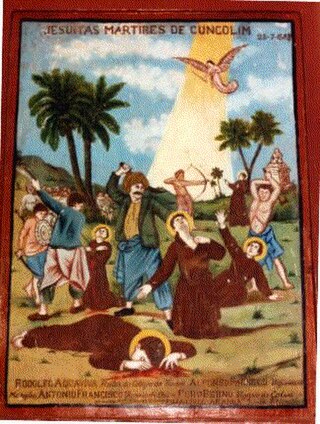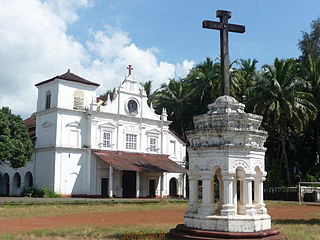
Francis Xavier, SJ, venerated as Saint Francis Xavier, was a Spanish Catholic missionary and saint who co-founded the Society of Jesus and, as a representative of the Portuguese Empire, led the first Christian mission to Japan.
Dom Diogo Rodrigues, Dom Diogo Roiz was a Portuguese explorer of the Indian Ocean who sailed as an ordinary helmsman under the command of Dom Pedro Mascarenhas around Goa. They sailed from the Cape of Good Hope eastward into little-known waters of the newly discovered route to Goa. Rodrigues island was named after him between 4 and 9 February 1528 because he had discovered it during his only return journey from Goa via Cochin to Lisbon, where he was elevated to the rank of a knight (cavaleiro) by John III of Portugal. He then returned to Goa and made a mark in the history of the Portuguese empire in the subcontinent around the mid-16th century.

Chorão, also known as Choddnnem or Chodan, is an island along the Mandovi River near Tiswadi, Goa, India. It is the largest among other 17 islands of Goa. It is located 5 kilometres away from the state capital, the city of Panaji and 10 kilometres away from the city of Mapusa.

The Cuncolim Massacre or Cuncolim Revolt was an incident that involved the massacre and mutilation of Christian priests and civilians by Hindu chieftains in the Portuguese Goa village of Cuncolim on Monday, 15 July 1583.
Goan Catholic literature is diverse.

Agnelo Gustavo Adolfo de Souza, was a Goan Roman Catholic priest of the Society of the Missionaries of St. Francis Xavier, Pilar who performed missionary work in the province of Goa, then part of Portuguese India. The cause for his canonization has been accepted for investigation by the Holy See, and has progressed to the point that he has been declared Venerable.

Rachol is a prominent village in the Salcete taluka (subdistrict) of South Goa district, Goa state, peninsular India. It is located on the left bank of the Zuari River and is home to the famous Rachol Seminary. The famous Portuguese colonial Rachol Fort has been completely erased, leaving behind the traces of the moat and the main gate. The village has many heritage structures and is an important site to study the history of Salcete. The Church of Our Lady of Snows at Rachol is said to be the first church of Salcete and is called the Matriz igreja de Salcette. Ilha de Rachol is a part of the village.

The Rachol Seminary, also known today as Patriarchal Seminary of Rachol, is the diocesan major seminary of the Primatial Catholic Archdiocese of Goa and Daman in Rachol, Goa, India.
Gaspar Jorge de Leão Pereira, or simply Gaspar de Leão Pereira or Gaspar de Leão was the first Archbishop of Goa.

St. Paul's College of Macau also known as College of Madre de Deus was a university founded in 1594 in Macau by Jesuits at the service of the Portuguese under the Padroado treaty. It claims the title of the first Western university in East Asia.
The art of printing first entered India through Goa. In a letter to St. Ignatius of Loyola, written on April 30, 1556, Father Gasper Caleza speaks of a ship carrying a printing press setting sail for Abyssinia from Portugal, with the purpose of helping missionary work in Abyssinia. Circumstances prevented this printing press from leaving India, and consequently, printing was initiated in the country.
Brother João de Bustamante or Juan de Bustamante, also known as 'the Indian Gutenberg', was a Spanish missionary who inaugurated the first era of print in India, specifically in the Portuguese colony of Goa.
Étienne de la Croix SJ, was a French Jesuit, missionary to India and author of a life of St Peter in Marathi: Discurso sobre a vida do Apostolo Sam Pedro em que se refuta os principaes erros do gentilismo.

The Igreja de Nossa Senhora das Neves is a historical Catholic church in Rachol village, Salcete sub-district, on the southern banks of the Zuari river, in the South Goa district of Goa state, India. The church was built in the 1560's during the Goa Inquisition. It is situated in close proximity to the renowned Rachol Seminary. There is a church of the same name in the neighbouring village of Raia.

Churches and Convents of Goa is the name given by UNESCO to a set of religious monuments located in Goa Velha, in the state of Goa, India, which were declared a World Heritage Site in 1986.

The Portuguese presence in Asia was responsible for what would be the first of many contacts between European countries and the East, starting on May 20, 1498 with the trip led by Vasco da Gama to Calicut, India. Aside from being part of the European colonisation of Southeast Asia in the 16th century, Portugal's goal in the Indian Ocean was to ensure their monopoly in the spice trade, establishing several fortresses and commercial trading posts.

Real Colégio de Educação de Chorão is a defunct Catholic seminary that was founded on 2 April 1761 in Chorão, India. It belonged to the Parish of Our Lady of Grace Church.
Melchior Nunes Barreto (Belchior) was a 16th century Portuguese Jesuit priest who acted as a missionary in India, China, and Japan. He was born c. 1520 in Porto (Oporto), Portugal, and died in Goa, Portuguese India on 6 October 1571. Some sources claim that he died on 10 August 1571.

Gaspar Vilela or Gaspar Villela, was a priest and Jesuit missionary, and his activity in Japan influenced the Portuguese and Christian presence.













